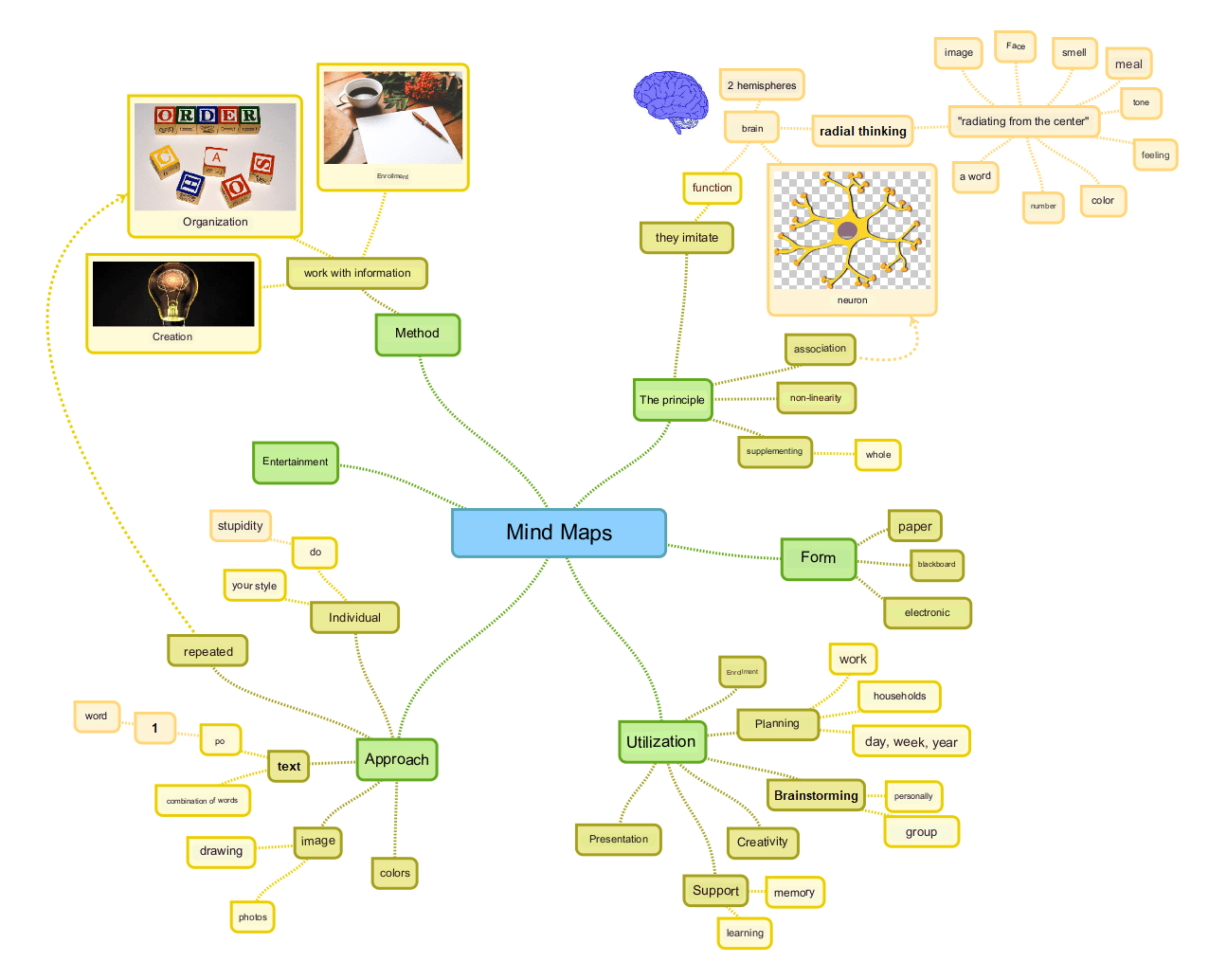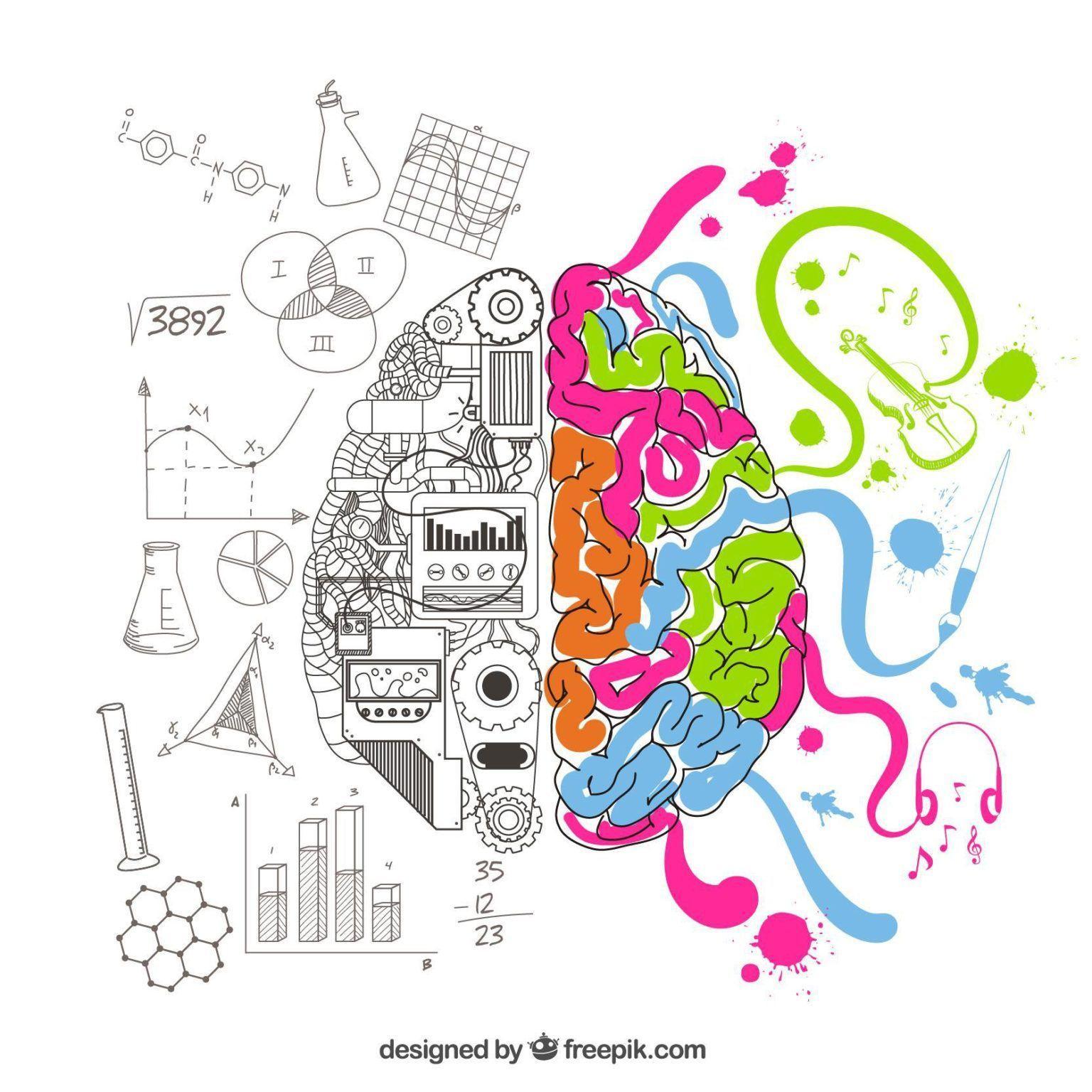Mind Maps: Streamline Work and Kick-Start Creativity
Mind maps help me write down and organize information, plan, and support memory and learning. They can be used as a brainstorming or presentation tool. What I appreciate most about mind maps is that they can be quick and encourage creativity. I will tell you more about them in the article.

The mind map that helped me write this article
A standard linear notation of thoughts
The standard linear thought map is the most widely used and popular method. It is also the way I am writing this text. This is writing in sentences, paragraphs, or pages. The ideas and words in standard linear notation go from point A to point B. This is the kind of notation we learn in primary school. Books are written using it, and we see it everywhere. The standard notation has its place and justification. However, mind maps should not replace them. They will find their use precisely where this notation is insufficient or ineffective.
The principle of mind maps
Brain functions
Mind maps mimic the function of the brain. This has many advantages. The brain has two hemispheres. Standard linear notation mainly uses the left hemisphere, which is responsible for the following:
- working with words,
- working with numbers,
- working with the order,
- analyzing and making lists,
- linearity,
- logic.
Mind maps also allow using the right hemisphere, which is responsible for the following:
- perception of rhythm,
- perception of space,
- color perception,
- perception of perspective,
- connecting parts into a whole,
- imagination,
- daydreaming.

Brain cell
The shape of a neuron reminds us at first glance of a mind map, from the center of which other branches emerge. The organizational structure of the information of the thought maps is thus natural for humans. The human brain contains one hundred billion neurons, and what is particularly fascinating is the speed of information transfer between neurons. Neurons can receive impulses from hundreds of thousands of connections every second.
Lightning speed
What happens in the brain when you bite into a pear, lean against a flower, listen to music, watch a river, touch another person, or think? Every piece of information that enters your head, every sensation – hearing, smell, sight, every word, number, image, or thought can be represented as a center point from which tens, hundreds, thousands, or millions of outbursts flash out.
This explosion can also be called radial thinking. The bottom line is that we have a central idea written in the center, which we branch out further, and the branching does not go from point A to point B, but at the same time, we are attacked by many ideas in all directions.
Associations and the need for the whole
The associations that thought maps trigger are also a positive outcome. So we feel more in contexts and have these thoughts written down in contexts.
The human brain needs to complete the whole. Therefore, if we see a blank space or an imperfect shape, the brain tries to fix it. When creating mind maps, we start at one point and expect them to branch out into multiple directions.
We know in advance that there will be, say, 5 to 6 of them, so the brain will do its best to fill in the required number with thoughts related to the central idea. Similarly, it branches out other studies emanating from the main view.
Use of thought maps
Notation
Within 5 minutes, I can create a full-fledged mind map with bare branches. So I have the main themes jotted down that I can develop later. Writing things down can be done, for example:
- an idea you just had and don’t want to forget,
- a summary of a book or scripts,
- meeting minutes,
- the outline of a blog article – for example, this one you are reading right now. 🙂
Planning
I can plan the essential points of a particular period through a single picture, whether a whole year, a month, a week, or a specific day. I use planning for the entire year.
At the beginning of the year, I make a map that I continuously update. I post it on the refrigerator. It gives me a clear picture of what’s coming up this year and which month is filled with meaningful activities and projects. At the same time, I know that I won’t be planning anything during this time. One can even design and organize a business or project through the mind map.
Brainstorming
You can brainstorm either with yourself or with colleagues at work. In addition to writing down ideas, more creative activity occurs during brainstorming with mind maps. Feel free to write down everything that comes to mind. You always need to find out which idea will end up on the main branch later, even if it initially seems nonsense.
Slideshow
You can use the finished mind map for a presentation. The advantage is that you have everything in one place. So you can show the client an insight into their business, the problem, and the solution all in one picture simultaneously. Alternatively, you can add another area related to the client and your solution as needed. You can also present it to colleagues.
Presentation
You can use the finished mind map for a presentation. The advantage is that you have everything in one place. So you can show the client an insight into their business, the problem, and the solution all in one picture. Alternatively, you can add another area related to the client and your solution as needed. You can also present it to colleagues.
Memory support
Because mind maps mimic the function of the brain, the information written down is better remembered. We see everything in context in one picture, so the effect of associations is always present. And that’s across the entire topic we cover in a single mind map.
Learning support
If you need to understand better and then remember an issue, try mind maps. At school, at work, or for your personal development. Importantly, learning becomes more enjoyable this way. You return to maps this way rather than to notes you have written down using the standard method.
For example, if you’re doing an online course, open the course itself in one window and the mind map application in the other. That way, you’re writing down new knowledge and creating the structure of the mind map in real-time. Gradually, you add ideas to areas you have already covered in earlier parts of the online course and link them to other sites. The ability to go back to notes from an earlier part of the course would be much more difficult in linear notation.
Encouraging creativity
As I mentioned, mind maps’ most significant added value is their ability to foster creativity. For example, mind maps have helped me prepare client analysis, insight into their business, and develop client solutions, strategies, and creative ideas.
Through the associations, I came up with topics that related not only to the client’s business but also directly to their brand and other aspects of their company. With mind maps, you’ll be churning out one idea after another – one idea will create the next in a flash, and so on. The best part is that all the ideas on one map will always be related. I see the creative potential of mind maps in the following:
- generating new ideas,
- developing ideas,
- creating marketing strategies,
- keyword analysis,
- preparing a new website or landing page,
- blogging or copywriting in general,
- starting a business plan,
- creating a new project (not only marketing),
- drawing and graphic design.
How to create mind maps?
The actual preparation of mind maps also involves the creative aspect of them. There are many ways to create them. In this article, we will only cover some of the specific steps to do it. I will only mention a few of them. At the same time, I will describe the basic principles of creation.
Paper vs. digital
You can create maps directly on paper or via an app. Both options have their pros and cons. Writing them on paper is faster and more immediate. It also engages more muscles. As we write or draw by hand, we also use other brain areas, further boosting creativity and memory.
In contrast, electronic writing is better because we can move, delete, or replace individual branches with others in real-time. We also can upload photos or images. So if someone is not artistically gifted, they can make up for the visual aspect of mind maps with digital photos.
The most important advantage of digital creation is the ability to work on your phone. I can jot down my thoughts almost anywhere, anytime. Some apps have cloud storage. So I usually finish a mind map on my desktop, where it’s more convenient and faster.
Text
Text in mind maps can be written in sentences or put only one word in each cell. Again, there is no rule. Both ways have their pros and cons. We can combine the text directly with an image or represent it visually – in a non-standard font.
Pictures
In addition to text, it is possible to include graphics in the creation. In this way, we further support radial thinking and other aspects of brain activity. Some mind maps look more like works of art rather than a record of thoughts. Since our brains love an image, this is perfectly fine.
Colors
One standard practice is to color the different branches of a mind map with different colors. We can also apply this at the level of individual cells or groups of cells independent of units.
The creator of mind maps – Tony Buzan
In conclusion, I recommend looking at books by Tony Buzan, the creator of mind maps. Try the book titled “Mind Maps” . From it, I drew most of the information for this article.
